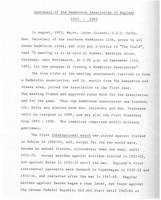
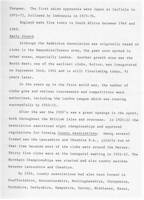
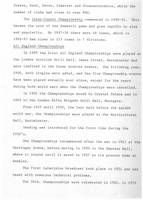
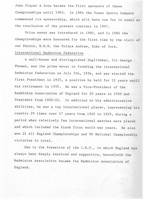
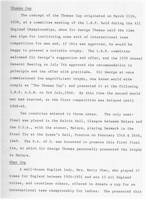
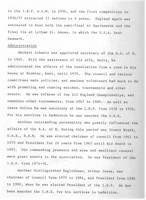
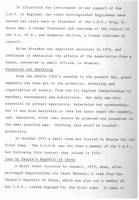
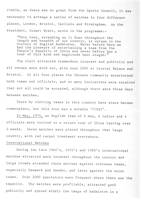
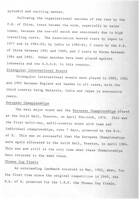
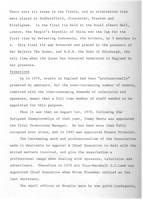
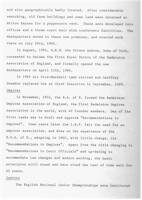
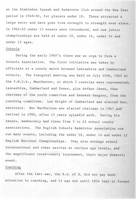
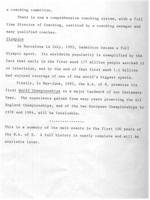
In August, 1893 Major, later Colonel, S. S. C. Dolby, Hon Secretary of the Southsea Badminton Club, wrote to all known badminton clubs, and also put a notice in "The Field", that "A meeting is to be held at Dunbar, Waverley Grove, Southsea near Portsmouth' at 2:00 p m on September 13th, 1893 for the purpose of forming a "Badminton Association".
The nine clubs at the meeting unanimously resolved to form a badminton Association, and 14 mostly from the Hampshire and Sussex area, joined the Association in the first year The meeting framed and approved rules both for the Association and for the game. Thus the Badminton Association was founded. Col Dolby was elected both Hon Secretary and Bon Treasurer until he resigned in 1899 and was also the first President from 1893 - 1898. The committee comprised mostly military gentlemen.
The first International match was played against Ireland in Dublin in 1902-03 and, except for the two world wars, became an annual fixture alternately home and away until 1971-72. Annual matches against Scotland started in 1921-22 and against Wales in 1932-33 until the war. England's first continental opponents were Denmark in Copenhagan in 1932-33 and 1933-34 and restarted after the war in 1947-48. Regular matches against Sweden began a year later, but those against the German Federal Republic did not start until 1965-66 at Torquay. The first Asian opponents were Japan at Carlisle in 1971-72, followed by Indonesia in 1975-76.
England made five tours to South Africa between 1948 and 1969.
Early Growth
Although the Badminton Association was originally based an clubs in the Hampshire/Sussex area, the game soon spread to other areas, especially London. Another growth area was the North West. one of the earliest clubs, Bolton, was inaugurated on September 26th, 1901 and is still flourishing today, 91 years later.
In the years up to the first world war, the number of clubs grew and various tournaments and competitions were authorised including the London League which was running successfully by 1901-11.
After the war the 1920's saw a great upsurge in the sport, both throughout the British Isles and overseas. In 1921-22 the Association sanctioned eight championships and approved regulations for forming County Associations. Among several formed was the Lancashire and Cheshire B. A., jointly run at that time because most of the clubs were around the Mersey. Thirty five clubs were at the inaugural meeting in 1921-22. The Northern Championships was started and also county matches between Lancashire and Cheshire.
By 1926 county associations had also been formed in Staffordshire. Worcestershire Nottinghamshire Shropshire Yorkshire, Derbyshire, Hampshire, Surrey, Middlesex, Essex, Sussex, Kent, Devon, Somerset and Gloucestershire while the number of clubs had risen to over 900.
The Inter-County Championship commenced in 1930-31 This became the core of the domestic game and grew rapidly in size and popularity By 1937-38 there were 48 teams, which in 1992-93 has risen to 115 teams in 7 divisions All England Championships.
In 1899 the first All England Championships were played at the London Scottish Drill Hall, James Street, Westminster and were confined to the three doubles events. The following year, 1900, both singles were added, and the five Championship events have been played annually ever since, except for the years during both world wars when the Championships were cancelled.
In 1902 the Championships moved to Crystal Palace and in 1903 to the London Rifle Brigade Drill Wall, Moorgate.
From 1910 until 1939, the last held before the second world war, the Championships were played at the Horticultural Ball, Westminster.
Seeding was introduced for the first time during the 1930's.
The Championships recommenced af ter the war in 1947 at the Harringay Arena, before moving in 1950 to the Empress Hall, where it stayed until it moved in 1957 to its present home at Wambley.
The first television broadcast took place in 1951 and was beset with numerous technical problems
The 50th Championships were celebrated in 1961. In 1970 John Player & Sons became the first sponsors of these Championships until 1983. In 1984 the Yonex Sports Company commenced its sponsorship, which will have run for 14 years at the conclusion of the present contract in 1997.
Prize money was introduced in 1980, and in 1986 the Championships were honoured for the first time by the visit of our Patron, H. R. H. the Prince Andrew, Duke of York.
International Badminton Federation.
A well-known and distinguished Englishman, Sir George Thomas was the prime mover in founding the International Badminton Federation on July 5th, 1934, and was elected the first President in 1935, a position he held for 21 years until his retirement in 1955. He was a Vice-President of the Badminton Association of England for 20 years to 1950 and President from 1950-52. In addition to his administrative abilities, he was a top international player, representing his country 29 times over 27 years from 1902 to 1929, during a period when relatively few international matches were played and which included the blank first world war years. He also won 21 All England Championships and 90 National Championship victories in total.
Due to the formation of the I.B.F., in which England has always been deeply involved and supportive, henceforth the Badminton Association became the Badminton Association of England.
Thomas Cup
The concept of the Thomas Cup originated on March 11th, 1939, at a committee meeting of the I.B.F. held during the All England Championship, when Sir George Thomas said the time was ripe for instituting some sort of international team competition for men and, if this was approved, he would be happy to present a suitable trophy. TheI.B.F. committee welcomed Sir George's suggestion and offer, and the 1939 Annual General Meeting on July 5th approved the recommendation in principle and the offer with gratitude. Sir George at once commissioned the magnificent trophy, now known world wide simply as 'The Thomas Cup'; and presented it at the following I.B.F. A.G.M. on 3rd July,1940. By this time the second world war had started, so the first competition was delayed until 1948-49.
Ten countries entered in three zones. The only semifinal was played in the Kelvin hall, Glasgow between Malaya and the U.S.A., with the winner, Malaya, playing Denmark in the Final Tie at the Queen's Hall, Preston on February 25th A 26th, 1949. The B.A. of E. was honoured to promote this first final tie, at which Sir George Thomas personally presented the trophy to Malaya
Uber Cup
A well-known English lady, Mrs. Betty Uber, who played 37 times for England between 1926-1951 and won 13 All England titles and countless others, offered to donate a cup for an international team championship for ladies. She presented this to the I B 9 A G U in 1956, and the first competition in 1956/57 attracted 11 nations in 4 zones England again was entrusted to host both the semi-final at Eastbourne and the final tie at Lytham St. Annes in which the U.S.A. beat Denmark
Administration
Herbert Scheele was appointed secretary of the B. A. of E. in 1945. With the assistance of his wife, Betty, he administered the affairs of the Association from a room in his house at Bromley, Kent, until 1970. The council and various committees made policies, and amateur volunteers had much to do with promoting and running matches, tournaments and other events. He was referee of the All England Championships, and numerous other tournaments, from 1947 to 1980. As well as these duties he was secretary of the I.B.F. from 1938 to 1976. For his services to badminton he was awarded the O.B.E.
Another outstanding personality who greatly influenced the affairs of the B.A. of E. during this period was Stuart Wyatt, O.B.E., B.EM. He was elected chairman of council from 1961 to 1970 and President for 20 years from 1965 until his death in 1985. His commanding presence and wise and emollient counsel were great assets to the Association. He was president of the I.B.F. from 1974-76.
Another distinguished Englishman, Arthur Jones, was chairman of council from 1975 to 1984, and President from 1986 to 1990, when he was elected President of the I.B.F. He has been awarded the C.B.E. for his services to badminton.
To illustrate the involvement in and support of the I .B.F. by England, two other distinguished Englishmen have served two years each as President of theI.B.F.; Brig. R. Bruce Hay, a former President and chairman of the council of the B. A. of E., and Humphrey Chilton, a former chairman of council.
Brian Bisseker was appointed secretary in 1970, and continued to administer the affairs of the Association from a house, converted to small offices, in Bromley.
Promotion and Marketing
From the middle 1960's onwards to the present day, great emphasis has been put on the promotion, marketing and organisation of events, from the All England Championships to matches, tournaments and exhibitians. Not only was this essential to attract spectators, television and sponsorship, but it was also desirable to take the sport round the country, and, therefore, vital that events be promoted and presented in the best possible way. Anything less would be counterproductive.
In October 1972 a small team was invited to Moscow for the first time. The U.S.S.R. was not then a member of the I.B.F. but following this contact they joined in 1974.
Tour by People's Republic of China
A major event occurred in January, 1973, when, after prolonged negotiations via their Embassy, a team from the People's Republic of China, which was also not a member of the I.B.F.. toured England for the first time. To make it viable, as there was no grant from the Sports Council, it was necessary to arrange a series of matches in four different places, London, Bristol, Carlisle and Birmingham. As the President, Stuart Wyatt, wrote in the programme:-
"This tour, extending as it does throughout the length and breadth of our country, in unique in the history of English Badminton. Never before have we had the pleasure of entertaining a team from the People's Republic of China and never before has a tour of this kind and magnitude been staged."
The visit attracted tremendous interest and publicity and all venues were sold out, with over 2000 at Crystal Palace and Bristol. At all four places the Chinese community entertained both teams and officials, and so many invitations were received that not all could be accepted, although there were three days between matches.
Tours by visiting teams to this country have since become commonplace, but this tour was a notable 'FIRST'.
In May, 1974, an English team of 6 men, 6 ladies and 4 officials were invited to a return tour of China lasting over 3 weeks. Seven matches were played throughout that large country, with red carpet treatment everywhere.
International Matches
During the late 1960's 1970's and l980's international matches attracted much interest throughout the country and large crowds attended these matches against overseas teams, especially Denmark and Sweden, and later against the Asian teams. Over 2000 spectators were frequent where there was the capacity. The matches were profitable, attracted good publicity and spread widely the image of badminton in a splendid and exciting manner.
Following the organisational success of the tour by the P.R. of China, tours became the norm, especially by Asian teams, because the one-off match was uneconomic due to the high travelling costs. The association hosted tours by Japan in 1977 and in 1981-82; by India in 1980-81; 5 tours by the P.R. of China between 1981 and 1989; and 3 tours by Korea between 1984 and 1990. Other matches have been played against Indonesia and the U.S.S.R. in the country.
Triangular International Events
Triangular international events were played in 1980, 1981 and 1982 between England and Sweden in all cases, with the third country being Malaysia, India and Japan in successive years.
European Championships
The next major event was the European Championships played at the Guild Hall, Preston, on April 9th-14th, 1978. This was the first multi-day multi-country event with team and individual championships, over 7 days, promoted by the B.A. of E. This was so successful that the European Championships were again allocated to the Guild Hall, Preston, in April 1984. This was and still is the only time when these Championships have returned to the same venue.
Thomas Cup Finals
An outstanding landmark occurred in May, 1982, when, for the first time since the original competition in 1949, the B.A. of E. promoted for the I.B.F. the Thomas Cup finals.
There were six teams in the finals, so elimination ties were played at Huddersfield, Gloucester, Preston and Birmingham. In the final tie held at the Royal Albert Hall, London, the People's Republic of China won the Cup for the first time by defeating Indonesia, the holders, by 5 matches to 4. This final tie was honoured and graced by the presence of Her Majesty The Queen, and H.R.H. the Duke of Edinburgh, the only time when the Queen has honoured badminton in England by her presence
Promotions
Up to 1978 events in England had been "professionally" promoted by amateurs, but the ever-increasing number of events, combined with the time-consuming demands of television and sponsors, meant that full time member of staff needed to be appointed for this purpose.
Thus it was that on August 1st, 1978 following the European Championships of that year, Tommy Marrs was appointed the first Promotions Manager. He has been more than fully occupied ever since, and in 1985 was appointed Events Director.
The increasing work and professionalism of the Association made it desirable to appoint a Chief Executive to deal with the miriad matters involved, and give the Association a professional image when dealing with sponsors, television and advertisers. Therefore in 1978 Air Vice-Marshall G.C. Lamb was appointed Chief Executive when Brian Bisseker retired as the last secretary.
The small offices at Bromley were by now quite inadequate, and also geographically badly located After considerable searching, old farm buildings and some land were obtained at Milton Keynes for a peppercorn rent These were developed into offices and a three court hall with conference facilities. The Headquarters moved to these new premises, and started work there on July 28th 1980.
In August, 1984 H.R.H. the Prince Andrew, Duke of York, consented to become the first Royal Patron of the Badminton Association of England, and formally opened the new Headquarters on April 12th, 1986.
In 1989 Air Vice-Marshall Lamb retired and Geoffrey Snowdon replaced him as Chief Executive in September, 1989.
Umpires
In November, 1952 the B.A.of E. formed the Badminton Umpires Association of England, the first Badminton Umpires Association in the world, with 40 founder members. One of its first tasks was to draft and approve "Recommendations to Umpires" Some years later the I.B.F. felt the need for an umpires association, and drew on the experience of the B.U.A. of E., adopting in 1960, with little change, its "Recommendations to Umpires". Apart from the title changing to "Recommendations to Court Officials" and up-dating to accommodate Law changes and modern wording, the basic principles still stand and have stood the test of time well for 40 years.
Juniors
The English National Junior Championships were instituted at the Wimbledon Squash and Badminton Club around the New Year period in 1949-50 for players under 18. These attracted a large entry and have gone from strength to strength ever since. In 1962-63 under 15 events were introduced, and now junior championships are held at under 18 under 16, under 14 and under 12 ages
Schools
During the early 1960's there was an urge to form Schools Association. The first initiative was taken by officials at a county match between Lancashire and Cumberland schools. The inaugural meeting was held on July 10th, 1965 at the Y.M.C.A., Manchester, at which 3 counties were represented; Lancashire, Cumberland and Essex, plus Arthur Jones, then chairman of the youth committee and Kenneth Geogory, from the coaching committee, Len Wright of Cumberland was elected Hon. secretary. Nev MacFarlane was elected chairman in 1967 and retired in 1990, after 23 years splendid work During his tenure, membership had risen from 3 to 43 school county associations. The English Schools Badminton Association now run many events, including the under 16, under 14 and under 12 English National Championships, They also arrange school international and other matches at various age levels and the magnificent inter-county tournament, their major domestic event.
Coaching
After the last war, the B A of E did not pay much attention to coaching, and it was not until 195A that it formed a coaching committee
Ä There is now a comprehensive coaching system, with a full time Director of Coaching, assisted by a coaching manager and many qualified coaches.
Olympics
In Barcelona in July, 1992, badminton became a full Olympic sport. Its worldwide popularity is exemplified by the fact that early in the first week 177 million people watched it on television, and by the and of that first week 1.1 billion had enjoyed coverage of one of the world's biggest sports.
Finally, in May-June, 1993, the B.A. of E. promotes its first World Championships as a major landmark of our Centenary Year. The experience gained from many years promoting the All England Championships, and of the two European Championships in 1978 and 1984, will be invaluable.
................
This is a summary of the main events in the first 100 years of the B A of E A full history is nearly complete and will be available later.
The original article scanned from a flyer announcing the Centennial. Click on these to see full resolution scan.
Contributed by by Rod Whiting.Please do not copy any of this without permission. Maintained by Stan Bischof. Last updated 13 Feb 2000 11:25